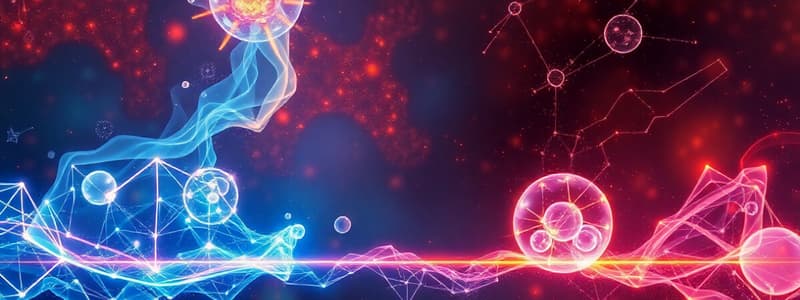Podcast
Questions and Answers
What does the law of mass action suggest about the concentrations of reactants and products at equilibrium?
What does the law of mass action suggest about the concentrations of reactants and products at equilibrium?
- Reactants always dominate products.
- The concentrations of reactants and products are equal.
- Products predominately form at equilibrium.
- Concentrations of both reactants and products remain constant. (correct)
Which of the following statements is true regarding the acid dissociation constant?
Which of the following statements is true regarding the acid dissociation constant?
- It is specific to weak acids in an aqueous solution. (correct)
- It equals the concentration of products at all times.
- It is irrelevant when calculating weak base reactions.
- It measures the rate of dissociation of a strong acid.
How does the base dissociation constant differ from the acid dissociation constant?
How does the base dissociation constant differ from the acid dissociation constant?
- The base dissociation constant is always greater than the acid dissociation constant.
- They represent the same equilibrium concept but for different types of compounds. (correct)
- The base dissociation constant is only relevant in non-aqueous solutions.
- The base dissociation constant applies only to strong bases.
In weak acid solutions, what is typically true about the concentrations of reactants and products during equilibrium?
In weak acid solutions, what is typically true about the concentrations of reactants and products during equilibrium?
What can be ignored when considering pressure changes on solids and liquids during reactions?
What can be ignored when considering pressure changes on solids and liquids during reactions?
Flashcards
Law of Mass Action
Law of Mass Action
Describes the relationship between the concentrations of reactants and products at equilibrium for a reversible reaction.
Weak Acid
Weak Acid
An acid that only partially dissociates into ions in an aqueous solution.
Acid Dissociation Constant (Ka)
Acid Dissociation Constant (Ka)
A measure of the strength of a weak acid, representing the ratio of the concentrations of products to reactants at equilibrium.
Weak Base
Weak Base
Signup and view all the flashcards
Base Dissociation Constant (Kb)
Base Dissociation Constant (Kb)
Signup and view all the flashcards
Solubility Product Constant (Ksp)
Solubility Product Constant (Ksp)
Signup and view all the flashcards
Equilibrium
Equilibrium
Signup and view all the flashcards
Study Notes
Chemical Equilibrium
- Chemical equilibrium is a state where the forward and reverse reactions occur at equal rates.
- The concentrations of reactants and products become constant, meaning no further net change in concentrations.
- This occurs when the rate of the forward reaction equals the rate of the reverse reaction.
Equilibrium Constant(Kc)
- Equilibrium constant expression: Kc = [products]/[reactants], where the exponents are the stoichiometric coefficients of the balanced reaction equation.
- Equilibrium constant values help determine the extent of reaction and prediction of the direction of a reaction.
- The larger the value of Kc, the further the reaction proceeds to form products before reaching equilibrium.
- A very small Kc means the reaction proceeds hardly at all, mostly reactants and their concentrations remain high.
Reaction Quotient(Qc)
- Reaction quotient is a similar calculation to Kc, but it is calculated at any point during the reaction, not just at equilibrium.
- If Qc < Kc, the reaction will proceed forward, favoring product formation
- If Qc > Kc, the reaction will proceed in the reverse direction, favoring reactant formation
- If Qc = Kc, the reaction is at equilibrium.
Factors Affecting Equilibrium
- Concentration: Adding more reactants or products shifts the equilibrium in the direction that consumes the added substance. Removing reactants or products shifts the equilibrium in the direction that generates the removed substance.
- Pressure and Volume: Increasing pressure/decreasing volume favors the side with fewer moles of gas. Conversely, decreasing pressure/increasing volume shifts the equilibrium towards the side with more moles of gas.
- Temperature: Endothermic reactions (positive ∆H°) shift to the right (products side) as temperature increases. Exothermic reactions (negative ∆H°) shift to the left (reactants side) as temperature increases.
Catalysts
- Catalysts speed up both forward and reverse reactions equally. This does not affect the equilibrium composition of the reaction mixture.
Le Chatelier's Principle
- If a change (stress) is applied to a system at equilibrium, the system shifts in a direction to relieve the stress.
Solubility Equilibria
- The solubility product constant (Ksp) describes the equilibrium between a solid ionic compound and its dissolved ions in a saturated solution.
- Adding a common ion to a solution reduces solubility of the solid compound.
Solubility and pH of the Solution
- Solubility of ionic compounds containing basic anions increases with increasing acidity of the solution.
- Salts with anions of strong acids are unaffected by pH changes.
Solubility and Complex Ions
- Solubility of ionic compounds increases dramatically if the solution contains a Lewis base that can coordinate with the metal cation.
- This forms complex ions, thus shifting the equilibrium to favor the dissolved state
Studying That Suits You
Use AI to generate personalized quizzes and flashcards to suit your learning preferences.




